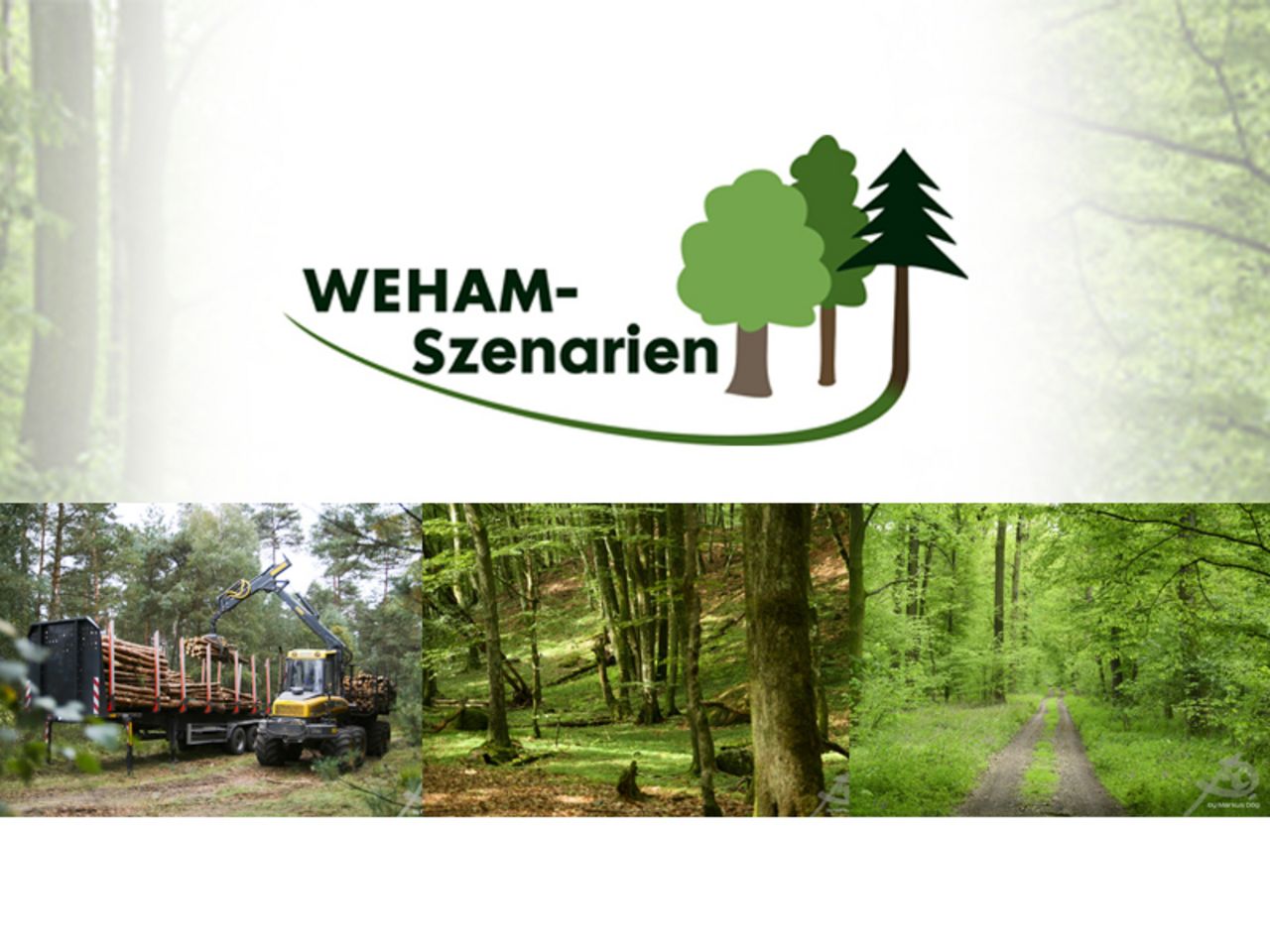Project
WEHAM-Scenarios

Assessment of the sustainability of different forest management and timber use scenarios, with a focus on climate protection and biodiversity conservation.
How to use the forest area in Germany? How much space should be protected and how much wood should be produced? How do we prepare forests for climate change? We need decision support to solve problems of conflicting forest utilization.
Background and Objective
Based on the National Forest Inventory (BWI) 2012, the German federal government and federal states, together with associations, developed the base-scenario for the forest development and timber resource modelling (WEHAM). The WEHAM-base scenario reflects future forest management and considers the current as well as the expected economic and legislative regulatory framework for forest management. The model takes into account current forest owner objectives in forest management, current and expected market conditions, as well as legal regulations like nature conservation.
In advance to the BWI 2012, stakeholders from politics, administration, associations and industry requested participation in the development of further WEHAM scenarios in order to identify and evaluate alternative scenarios of forest management and timber use.
Against this backdrop, the goal of the joint research project "WEHAM scenarios" was the development of forest management and timber use scenarios in a stakeholder participation process.The results were evaluated by means of a sustainability assessment, in particular to answer questions in regard to the protection of climate and biodiversity.
Target Group
Politics, administration, associations, economy
Approach
In this research project, we intended to develop forest management and timber use scenarios based on a participative stakeholderprocess, and to conduct a sustainability assessment to evaluate scenario results, particularly focussing on climate change and biodiversity.
Data and Methods
With the help of stakeholders, we collected data to identify expectations of different stakeholdergroups on forest management and timber resources and summarized this information in scenarios.
Part of this data for scenario development was, for example, information on regional raw wood demand for energy and material use.
We assessed the sustainability of the sceanrios with the help of indicators. This allowed for comparison of economic, ecologic and social impacts of forest management and wood use. To evaluate how different scenarios of forest management reflect on biodiversity, we developed and tested a WEHAM-adjusted method.
Our Research Questions
What demands do stakeholders have in regard to the future use of forests and timber?
How would the implementation of these demands affect the forest structure and the future supply of timber?
What would be the economic, environmental and social consequences of the change in forest structure and the amount of raw wood?
Results
Links and Downloads
Thünen-Contact

Involved Thünen-Partners
- Dunger, Karsten WO Institute of Forest Ecosystems
- Klatt, SusannWO Institute of Forest Ecosystems
- Oehmichen, Katja WO Institute of Forest Ecosystems
- Rosenkranz, LydiaWF Institute of Forestry
- Rüter, Sebastian HF Institute of Wood Research
- Schier, FranziskaWF Institute of Forestry
- Schweinle, Jörg WF Institute of Forestry
- Weimar, Holger WF Institute of Forestry
Involved external Thünen-Partners
-
Hochschule für nachhaltige Entwicklung Eberswalde (HNEE)
(Eberswalde, Deutschland) -
Universität Hamburg
(Hamburg, Deutschland)
Funding Body
-
Federal Ministry of Food und Agriculture (BMEL)
(national, öffentlich) -
Federal Ministry for the Environment, Nature Conservation, Building and Nuclear Safety (BMUB)
(national, öffentlich)
Duration
10.2014 - 6.2017
More Information
Project funding number: 28W-C-4-043-01
Funding program: Waldklimafonds (Programmbestandteil des Sondervermögens Energie- und Klimafonds)
Project status:
finished
List of Publications
- 0
Seintsch B, Döring P, Dunger K, Gerber K, Glasenapp S, Klatt S, Linde A, Mantau U, Meier-Landsberg E, Oehmichen K, Reise J, Rüter S, Saal U, Schweinle J, Schier F, Selzer AM, Rosenkranz L, Wenz E, Weimar H, Winter S (2017) Das WEHAM-Szenarien-Verbundforschungsprojekt. AFZ Der Wald 72(13):10-13
- 1
Oehmichen K, Röhling S, Dunger K, Gerber K, Klatt S (2017) Ergebnisse und Bewertung der alternativen WEHAM-Szenarien. AFZ Der Wald 72(13):14-17
- 2
Schier F, Weimar H (2017) Modellierung des Holzmarktes im WEHAM-Projekt. AFZ Der Wald 72(13):21-23
- 3
Meier-Landsberg E, Schweinle J (2017) Nachhaltigkeitsbewertung der WEHAM-Szenarien. AFZ Der Wald 72(13):27-29
- 4
Rosenkranz L, Seintsch B (2017) Ökonomische Analysen der Szenarien. AFZ Der Wald 72(13):24-26
- 5
Rüter S, Stümer W, Dunger K (2017) Treibhausgasbilanzen der WEHAM-Szenarien. AFZ Der Wald 72(13):30-31
- 6
Rosenkranz L, Selzer AM, Seintsch B, Dunger K, Döring P, Gerber K, Glasenapp S, Klatt S, Kukulka F, Meier-Landsberg E, Linde A, Mantau U, Oehmichen K, Reise J, Röhling S, Saal U, Schier F, Schweinle J, Weimar H, Winter S (2017) Verbundforschungsbericht WEHAM-Szenarien : Stakeholderbeteiligung bei der Entwicklung und Bewertung von Waldbehandlungs- und Holzverwendungsszenarien. Braunschweig: Johann Heinrich von Thünen-Institut, 129 p, Thünen Working Paper 73, DOI:10.3220/WP1499246183000
- 7
Rosenkranz L, Diederichs SK, Döring P, Dunger K, Gerber K, Glasenapp S, Klatt S, Kukulka F, Mantau U, Meier E, Oehmichen K, Reise J, Rock J, Rüter S, Saal U, Schweinle J, Schier F, Weimar H, Winter S, Seintsch B (2015) Waldbehandlung und Holzverwendung in der Zukunft. AFZ Der Wald 70(23):45-47

![[Translate to English:] Logo des Bundesministerium für Ernährung und Landwirtschaft](/media/allgemein/logos/BMEL_Logo.svg)